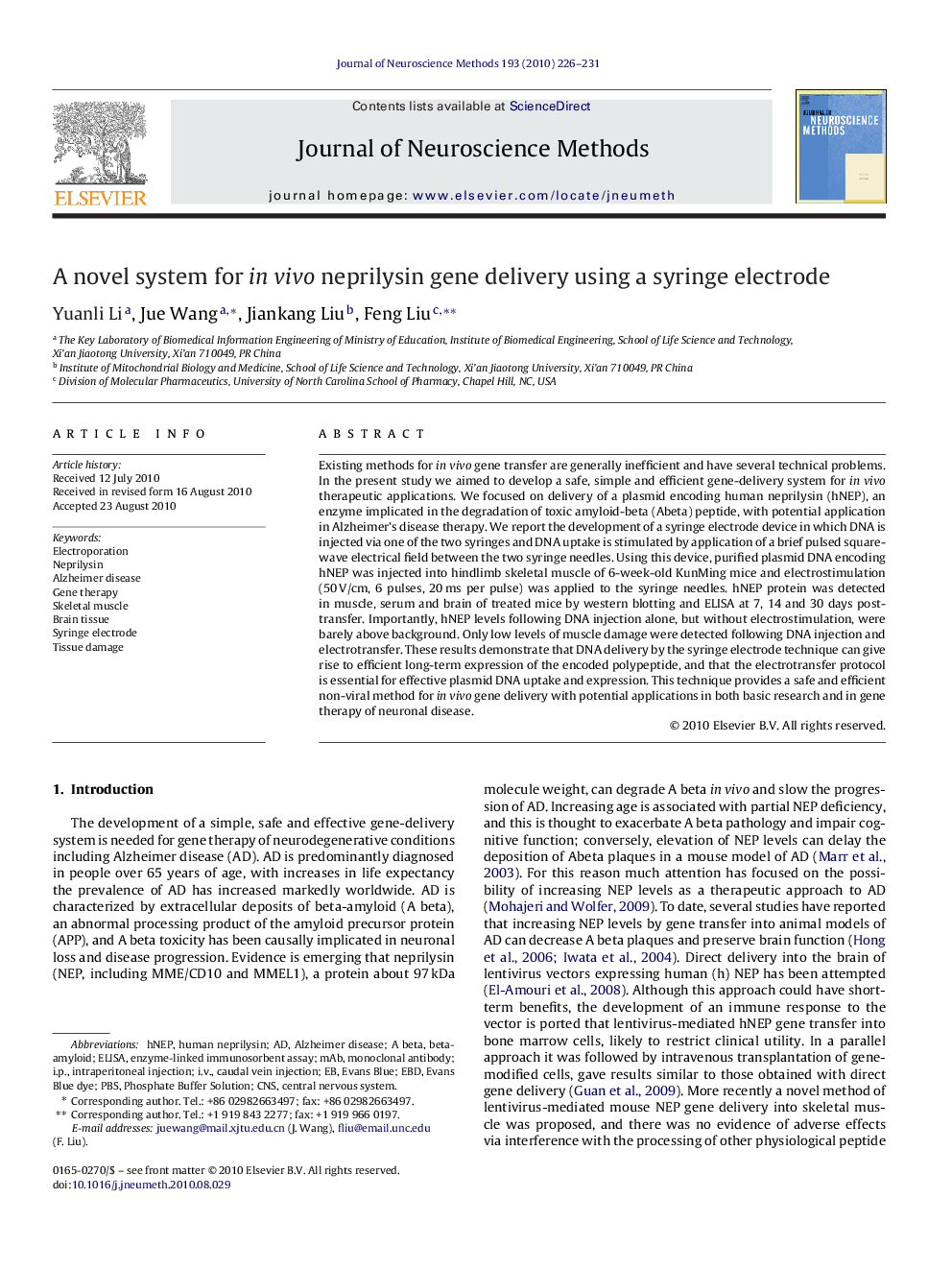| کد مقاله | کد نشریه | سال انتشار | مقاله انگلیسی | نسخه تمام متن |
|---|---|---|---|---|
| 6269912 | 1295164 | 2010 | 6 صفحه PDF | دانلود رایگان |

Existing methods for in vivo gene transfer are generally inefficient and have several technical problems. In the present study we aimed to develop a safe, simple and efficient gene-delivery system for in vivo therapeutic applications. We focused on delivery of a plasmid encoding human neprilysin (hNEP), an enzyme implicated in the degradation of toxic amyloid-beta (Abeta) peptide, with potential application in Alzheimer's disease therapy. We report the development of a syringe electrode device in which DNA is injected via one of the two syringes and DNA uptake is stimulated by application of a brief pulsed square-wave electrical field between the two syringe needles. Using this device, purified plasmid DNA encoding hNEP was injected into hindlimb skeletal muscle of 6-week-old KunMing mice and electrostimulation (50Â V/cm, 6 pulses, 20Â ms per pulse) was applied to the syringe needles. hNEP protein was detected in muscle, serum and brain of treated mice by western blotting and ELISA at 7, 14 and 30 days post-transfer. Importantly, hNEP levels following DNA injection alone, but without electrostimulation, were barely above background. Only low levels of muscle damage were detected following DNA injection and electrotransfer. These results demonstrate that DNA delivery by the syringe electrode technique can give rise to efficient long-term expression of the encoded polypeptide, and that the electrotransfer protocol is essential for effective plasmid DNA uptake and expression. This technique provides a safe and efficient non-viral method for in vivo gene delivery with potential applications in both basic research and in gene therapy of neuronal disease.
Research highlightsⶠIn our study, we have showed that an attractive methodology of neuronal gene delivery in vivo for application in basic researches and preclinical trials in gene therapy for neurodegeneration in Alzheimer's disease. ⶠFollowing injection of purified naked human (h) neprilysin (NEP) plasmids solution in hindlimb skeletal muscle of 6-week-old KunMing mice with optimal electrotransfer conditions (50 V/cm, 6 pulses, and 20 ms per pulse) using a syringe electrode of our design. hNEP protein levels were observed evidently in local skeletal muscle for at least 1 month. ⶠWe also observed evidently enhanced hNEP levels (about 6500 pg/ml) for at least 1 month in peripheral blood following syringe electrode delivery into skeletal muscle. It proved that hNEP protein expression in local skeletal muscle can be efficiently secreted into the circulation. ⶠWhile, increased hNEP levels were tested in brain tissue for at least 1 month, with significant efficiency compared to that of control groups; this result indicates that hNEP secreted from injected muscle following electrotransfer can enter the brain tissue. ⶠWith Evans Blue dye in skeletal muscle, the results obtained have showed very low tissue damage.
Journal: Journal of Neuroscience Methods - Volume 193, Issue 2, 30 November 2010, Pages 226-231